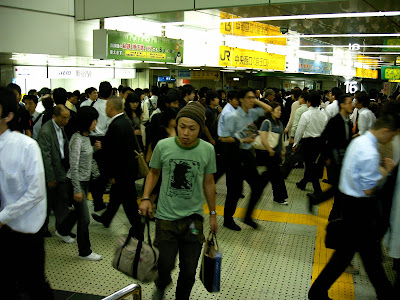On Saturday, September 22, Junya OOBA, a friend of mine, and I visited the construction site of Mr. UEDA, a timber frame builder and architect. UEDA has an architect’s license (of the highest degree in Japan), but works mainly as a timber framer.

The Japanese art of timber framing is known as 宮大工 (Miyadaiku), which literally means temple carpentry. Due the natural abundance of trees and high humidity that rusts nails, Japan has a long tradition of timber framing.
 Traditionally, 荒土壁 (aratsuchikabe), that is walls of bamboo and mud plaster, are built between posts. Junya checks out the plaster mixing station: trough, mud, chopped straw.
Traditionally, 荒土壁 (aratsuchikabe), that is walls of bamboo and mud plaster, are built between posts. Junya checks out the plaster mixing station: trough, mud, chopped straw.

As commercial building materials become the norm, traditional timber framing is not being included in modern building codes. Mr. UEDA is a member of a study group that actually runs experiments to provide data to building officials.










 Above is Shinjuku station. Below is Ichigaya station, the station closest to my Japanese language course.
Above is Shinjuku station. Below is Ichigaya station, the station closest to my Japanese language course.

 Traditionally, 荒土壁 (aratsuchikabe), that is walls of bamboo and mud plaster, are built between posts. Junya checks out the plaster mixing station: trough, mud, chopped straw.
Traditionally, 荒土壁 (aratsuchikabe), that is walls of bamboo and mud plaster, are built between posts. Junya checks out the plaster mixing station: trough, mud, chopped straw.

 Kawaguchi-san is the leader of a no-till, organic, non-mechanized agricultural movement and teaches at Akame Natural Farming School once a month. I attended Akame’s monthly gatherings when I lived in Wakayama. Kawaguchi-san also teaches Chinese herbal medicine. I hope to have the time someday to translate his books.
Kawaguchi-san is the leader of a no-till, organic, non-mechanized agricultural movement and teaches at Akame Natural Farming School once a month. I attended Akame’s monthly gatherings when I lived in Wakayama. Kawaguchi-san also teaches Chinese herbal medicine. I hope to have the time someday to translate his books. I worked closely with Hashimoto-san for 18 months. He was one of my first agricultural mentors. He has expanded since we worked together, and now has a full-time assistant. Most notably, he now produces over 2000 liters of soy sauce a year. In addition, he’s now almost 90 percent seed self-sufficient, that is, he saves almost all of his own seed.
I worked closely with Hashimoto-san for 18 months. He was one of my first agricultural mentors. He has expanded since we worked together, and now has a full-time assistant. Most notably, he now produces over 2000 liters of soy sauce a year. In addition, he’s now almost 90 percent seed self-sufficient, that is, he saves almost all of his own seed.